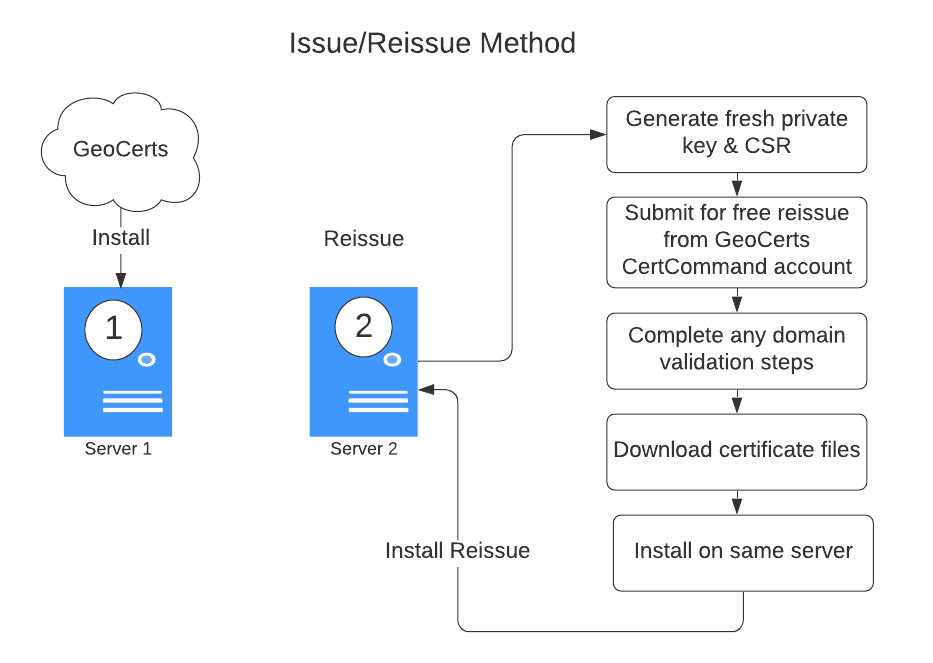How to install an SSL certificate on multiple servers
"How do I install my SSL certificate on more than one server?" We get asked this question a lot.
Why would you need to install on multiple servers?
If you buy a wildcard SSL certificate you may want to use that certificate across multiple servers that share the same base domain. Or perhaps you purchase a multi-domain certificate, issued for many different domains, and you want to use it across multiple servers.
There are generally two methods used to deploy a single SSL certificate across multiple servers: The Export/Import method and the Issue/Reissue method. We'll discuss both.
The Export/Import method
The Export/Import method is the easiest and most popular option, especially for Windows servers. Start with server 1 and then export the SSL keys from server 1 and import to server 2, server 3, and so on. With this method, you'll be using the exact same private key and SSL certificate on each server.
- Install your SSL certificate on server 1.
- Save your SSL keys from server 1 to a file.
- Import the keys you saved from step 2 into server 3 and repeat for additional servers.
The Issue/Reissue method
The Issue/Reissue method is more complex and time-consuming, but it's also considered more secure and a best practice in distributing private keys across multiple servers. With this method you'll be using a unique private key and SSL certificate on each server. First, you issue a certificate for server 1 and the request free c certificate reissues for each additional server.
- Install your SSL certificate as normal on server 1.
- From server 2, generate a fresh private key and Certificate Signing Request (CSR).
- Login to your GeoCerts CertCommand account, find the order, and submit the new CSR for a free reissue.
- Complete any pending domain and/or organization validation steps required.
- When the reissue is complete, download the certificate files from your account and install them on server 2.
- For each additional server, repeat steps 2 through 5 above.
Which method should I use?
Picking the best method depends on the brand/type of servers you are working with. Are they all Windows servers? Are they all Java servers? Or are they a mix of different brands/types of servers? Below we have compiled our recommendations for the most popular servers and use cases.
Windows-to-Windows servers
Recommended method: Export/Import
For Windows servers, like IIS and Exchange, we recommend using the Export/Import method described above. Windows makes it super easy to backup your SSL keys to a Personal Information Exchange (PFX) archive. A PFX file is a single, password-protected certificate archive that contains the entire certificate chain plus the matching private key. Essentially it is everything that any Windows server will need to import a certificate and private key from a single file.
- Learn how to Export & import SSL certificates between Windows servers with a PFX file
- Learn how to download a PFX file?
Java-to-Java servers
Recommended method: Export/Import
Java-based servers, like Tomcat, use Java Keystores as a storage repository for public key SSL/TLS certificates and their corresponding private keys. A Keystore is created and managed using the keytool command. A Keystore does not contain any information which ties it to a specific system or server so it can be freely copied between servers as needed.
- Learn how to generate a Jave Keystore, private key, and CSR
- Learn how to install an SSL certificate into a Java Keystore
Apache-to-Apache & NGINX-to-NGINX servers
Recommended method: Issue/Reissue
Apache servers do not use a single repository file to store it's public key SSL/TLS certificates and their corresponding private keys. Rather Apache configuration files point to individual certificate and private key files. For this reason, we think it's just easier, and a best practice, to use the Issue/Reissue method rather than trying to copy certificate files from one server to another.
- Learn how to generate a private key and CSR for Apache
- Learn how to install an SSL certificate on Apache
Brand-X to Brand-Y servers
Recommended method: Issue/Reissue
If you have a certificate and private key working on, say, a Windows server and you want to also use it on, maybe, a Java-based server like Tomcat, do not waste your time and frustrate yourself trying to convert a PFX certificate archive to a Java Keystore archive. Use the Issue/Reissue method instead. Generate a new private key and CSR from each type of server and submit for individual reissues.

